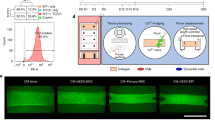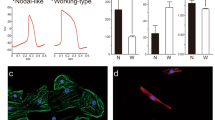Abstract
Transplantation studies in mice and rats have shown that human embryonic-stem-cell-derived cardiomyocytes (hESC-CMs) can improve the function of infarcted hearts1,2,3, but two critical issues related to their electrophysiological behaviour in vivo remain unresolved. First, the risk of arrhythmias following hESC-CM transplantation in injured hearts has not been determined. Second, the electromechanical integration of hESC-CMs in injured hearts has not been demonstrated, so it is unclear whether these cells improve contractile function directly through addition of new force-generating units. Here we use a guinea-pig model to show that hESC-CM grafts in injured hearts protect against arrhythmias and can contract synchronously with host muscle. Injured hearts with hESC-CM grafts show improved mechanical function and a significantly reduced incidence of both spontaneous and induced ventricular tachycardia. To assess the activity of hESC-CM grafts in vivo, we transplanted hESC-CMs expressing the genetically encoded calcium sensor, GCaMP3 (refs 4, 5). By correlating the GCaMP3 fluorescent signal with the host ECG, we found that grafts in uninjured hearts have consistent 1:1 host–graft coupling. Grafts in injured hearts are more heterogeneous and typically include both coupled and uncoupled regions. Thus, human myocardial grafts meet physiological criteria for true heart regeneration, providing support for the continued development of hESC-based cardiac therapies for both mechanical and electrical repair.
This is a preview of subscription content, access via your institution
Access options
Subscribe to this journal
Receive 51 print issues and online access
$199.00 per year
only $3.90 per issue
Buy this article
- Purchase on Springer Link
- Instant access to full article PDF
Prices may be subject to local taxes which are calculated during checkout



Similar content being viewed by others
References
Caspi, O. et al. Transplantation of human embryonic stem cell-derived cardiomyocytes improves myocardial performance in infarcted rat hearts. J. Am. Coll. Cardiol. 50, 1884–1893 (2007)
Laflamme, M. A. et al. Cardiomyocytes derived from human embryonic stem cells in pro-survival factors enhance function of infarcted rat hearts. Nature Biotechnol. 25, 1015–1024 (2007)
van Laake, L. W. et al. Human embryonic stem cell-derived cardiomyocytes survive and mature in the mouse heart and transiently improve function after myocardial infarction. Stem Cell Res. 1, 9–24 (2007)
Tallini, Y. N. et al. Imaging cellular signals in the heart in vivo: cardiac expression of the high-signal Ca2+ indicator GCaMP2. Proc. Natl Acad. Sci. USA 103, 4753–4758 (2006)
Tian, L. et al. Imaging neural activity in worms, flies and mice with improved GCaMP calcium indicators. Nature Methods 6, 875–881 (2009)
Kehat, I. et al. Electromechanical integration of cardiomyocytes derived from human embryonic stem cells. Nature Biotechnol. 22, 1282–1289 (2004)
Xue, T. et al. Functional integration of electrically active cardiac derivatives from genetically engineered human embryonic stem cells with quiescent recipient ventricular cardiomyocytes: insights into the development of cell-based pacemakers. Circulation 111, 11–20 (2005)
Gepstein, L. et al. In vivo assessment of the electrophysiological integration and arrhythmogenic risk of myocardial cell transplantation strategies. Stem Cells 28, 2151–2161 (2010); erratum 29, 1475 (2011).
Liao, S. Y. et al. Proarrhythmic risk of embryonic stem cell-derived cardiomyocyte transplantation in infarcted myocardium. Heart Rhythm 7, 1852–1859 (2010)
Roell, W. et al. Engraftment of connexin 43-expressing cells prevents post-infarct arrhythmia. Nature 450, 819–824 (2007)
Kehat, I. et al. Human embryonic stem cells can differentiate into myocytes with structural and functional properties of cardiomyocytes. J. Clin. Invest. 108, 407–414 (2001)
He, J. Q., Ma, Y., Lee, Y., Thomson, J. A. & Kamp, T. J. Human embryonic stem cells develop into multiple types of cardiac myocytes: action potential characterization. Circ. Res. 93, 32–39 (2003)
Zhu, W. Z. et al. Neuregulin/ErbB signaling regulates cardiac subtype specification in differentiating human embryonic stem cells. Circ. Res. 107, 776–786 (2010)
Mandel, Y. et al. Human embryonic and induced pluripotent stem cell-derived cardiomyocytes exhibit beat rate variability and power-law behavior. Circulation 125, 883–893 (2012)
Jonsson, M. K. et al. Quantified proarrhythmic potential of selected human embryonic stem cell-derived cardiomyocytes. Stem Cell Res. 4, 189–200 (2010)
Chen, H. S., Kim, C. & Mercola, M. Electrophysiological challenges of cell-based myocardial repair. Circulation 120, 2496–2508 (2009)
Swoap, S. J., Overton, J. M. & Garber, G. Effect of ambient temperature on cardiovascular parameters in rats and mice: a comparative approach. Am. J. Physiol. Regul. Integr. Comp. Physiol. 287, R391–R396 (2004)
Mummery, C. et al. Differentiation of human embryonic stem cells to cardiomyocytes: role of coculture with visceral endoderm-like cells. Circulation 107, 2733–2740 (2003)
Shiotani, M., Harada, T., Abe, J., Hamada, Y. & Horii, I. Methodological validation of an existing telemetry system for QT evaluation in conscious guinea pigs. J. Pharmacol. Toxicol. Methods 55, 27–34 (2007)
Zhu, W. Z., Van Biber, B. & Laflamme, M. A. Methods for the derivation and use of cardiomyocytes from human pluripotent stem cells. Methods Mol. Biol. 767, 419–431 (2011)
Hockemeyer, D. et al. Efficient targeting of expressed and silent genes in human ESCs and iPSCs using zinc-finger nucleases. Nature Biotechnol. 27, 851–857 (2009)
Lieu, D. K. et al. Absence of transverse tubules contributes to non-uniform Ca(2+) wavefronts in mouse and human embryonic stem cell-derived cardiomyocytes. Stem Cells Dev. 18, 1493–1500 (2009)
Kotlikoff, M. I. Genetically encoded Ca2+ indicators: using genetics and molecular design to understand complex physiology. J. Physiol. (Lond.) 578, 55–67 (2007)
Thomson, J. A. et al. Embryonic stem cell lines derived from human blastocysts. Science 282, 1145–1147 (1998)
Xu, C. et al. Feeder-free growth of undifferentiated human embryonic stem cells. Nature Biotechnol. 19, 971–974 (2001)
Li, Y., Powell, S., Brunette, E., Lebkowski, J. & Mandalam, R. Expansion of human embryonic stem cells in defined serum-free medium devoid of animal-derived products. Biotechnol. Bioeng. 91, 688–698 (2005)
Xu, C. et al. Efficient generation and cryopreservation of cardiomyocytes derived from human embryonic stem cells. Regen. Med. 6, 53–66 (2011)
Shiotani, M. et al. Practical application of guinea pig telemetry system for QT evaluation. J. Toxicol. Sci. 30, 239–247 (2005)
Walker, M. J. et al. The Lambeth Conventions: guidelines for the study of arrhythmias in ischaemia infarction, and reperfusion. Cardiovasc. Res. 22, 447–455 (1988)
Gutstein, D. E., Danik, S. B., Sereysky, J. B., Morley, G. E. & Fishman, G. I. Subdiaphragmatic murine electrophysiological studies: sequential determination of ventricular refractoriness and arrhythmia induction. Am. J. Physiol. Heart Circ. Physiol. 285, H1091–H1096 (2003)
Biermann, M. et al. Differential effects of cytochalasin D and 2,3 butanedione monoxime on isometric twitch force and transmembrane action potential in isolated ventricular muscle: implications for optical measurements of cardiac repolarization. J. Cardiovasc. Electrophysiol. 9, 1348–1357 (1998)
Laurita, K. R. & Singal, A. Mapping action potentials and calcium transients simultaneously from the intact heart. Am. J. Physiol. Heart Circ. Physiol. 280, H2053–H2060 (2001)
Fedorov, V. V. et al. Application of blebbistatin as an excitation-contraction uncoupler for electrophysiologic study of rat and rabbit hearts. Heart Rhythm 4, 619–626 (2007)
Kolega, J. Phototoxicity and photoinactivation of blebbistatin in UV and visible light. Biochem. Biophys. Res. Commun. 320, 1020–1025 (2004)
Asfour, H., Swift, L. M., Sarvazyan, N., Doroslovacki, M. & Kay, M. W. Signal decomposition of transmembrane voltage-sensitive dye fluorescence using a multiresolution wavelet analysis. IEEE Trans. Biomed. Eng. 58, 2083–2093 (2011)
Kay, M., Swift, L., Martell, B., Arutunyan, A. & Sarvazyan, N. Locations of ectopic beats coincide with spatial gradients of NADH in a regional model of low-flow reperfusion. Am. J. Physiol. Heart Circ. Physiol. 294, H2400–H2405 (2008)
Swift, L. et al. Controlled regional hypoperfusion in Langendorff heart preparations. Physiol. Meas. 29, 269–279 (2008)
Fernandes, S. et al. Human embryonic stem cell-derived cardiomyocytes engraft but do not alter cardiac remodeling after chronic infarction in rats. J. Mol. Cell. Cardiol. 49, 941–949 (2010)
Laflamme, M. A. et al. Formation of human myocardium in the rat heart from human embryonic stem cells. Am. J. Pathol. 167, 663–671 (2005)
Kuznetsov, S. A. et al. Circulating skeletal stem cells. J. Cell Biol. 153, 1133–1140 (2001)
Acknowledgements
We thank Y. Tallini, L. Linares, B. Johnson and S. Dupras for advice and technical assistance. This work was partly supported by a grant from Geron Corporation (M.A.L.), as well as by US National Institutes of Health grants K08-HL80431 (M.A.L.), R01-HL064387 (M.A.L. and C.E.M.), P01-HL094374 (M.A.L. and C.E.M.), R01-HL084642 (C.E.M.), P01-GM81619 (C.E.M.), U01-HL100405 (M.A.L. and C.E.M.) and R01-HL095828 (N.S. and M.W.K.). Animal experiments were supported in part by the University of Washington’s Mouse Metabolic Phenotyping Center, U24-DK076126.
Author information
Authors and Affiliations
Contributions
Author Contributions S.F., Y.S., W.-Z.Z., D.F., M.I.K., J.D.G., C.E.M. and M.A.L. designed the study. Y.S. and S.F. led the arrhythmia and calcium imaging experiments, respectively. Y.S. developed and performed the telemetry and programmed electrical stimulation. T.D., J.L.M., A.I., R.H. and M.V. performed telemetric ECG interpretation. The GCaMP3-expressing hESC line was generated by J.G., N.J.P. and B.V.B. V.M., J.K., K.W.M., S.F. and Y.S. carried out and analysed immunohistochemistry experiments. S.F., H.R. and M.A.L. developed and performed guinea-pig-specific in situ hybridization. S.F., W.-Z.Z. and D.F. carried out and analysed the GCaMP3 imaging experiments. D.F., M.W.K. and N.S. developed and analysed the voltage mapping experiments. All authors contributed to data analysis and interpretation. Y.S. created the figures with the assistance of S.F., W.-Z.Z., K.W.M. and D.F. C.E.M. and M.A.L. wrote the manuscript.
Corresponding authors
Ethics declarations
Competing interests
J.D.G. was an employee of Geron Corporation when many of these experiments were performed. M.A.L. and C.E.M. are founders and equity holders in BEAT Bio.
Supplementary information
Supplementary Information
This file contains Supplementary Figures 1-14, Supplementary Tables 1-4, additional references and legends for Supplementary Movies 1-6. (PDF 2175 kb)
Supplementary Movie 1
This movie shows that GCaMP3-positive hESC-CMs exhibit robust fluorescent transients in vitro (see Supplementary Information file for full legend). (MOV 6990 kb)
Supplementary Movie 2
This movie shows intravital imaging of GCaMP3-positive hESC-CM grafts in the uninjured heart (see Supplementary Information file for full legend). (MOV 8809 kb)
Supplementary Movie 3
This movie shows confocal Z-stack of a GCaMP3-positive hESC-CM graft that has been dual-labeled with anti-GFP and guinea pig-specific in situ probe(see Supplementary Information file for full legend). (MOV 1917 kb)
Supplementary Movie 4
This movie shows intravital imaging of a cryoinjured heart with GCaMP3-positive hESC-CM graft that exhibited uniform 1:1 host-graft coupling (see Supplementary Information file for full legend). (MOV 1493 kb)
Supplementary Movie 5
This movie shows intravital imaging of a cryoinjured heart with GCaMP3-positive hESC-CM graft that was not coupled with host myocardium (see Supplementary Information file for full legend). (MOV 1562 kb)
Supplementary Movie 6
This movie shows intravital imaging of a cryoinjured heart with coupled and uncoupled GCaMP3-positive hESC-CM graft, examined under spontaneous and paced conditions (see Supplementary Information file for full legend). (MOV 8483 kb)
Rights and permissions
About this article
Cite this article
Shiba, Y., Fernandes, S., Zhu, WZ. et al. Human ES-cell-derived cardiomyocytes electrically couple and suppress arrhythmias in injured hearts. Nature 489, 322–325 (2012). https://doi.org/10.1038/nature11317
Received:
Accepted:
Published:
Issue Date:
DOI: https://doi.org/10.1038/nature11317
This article is cited by
-
Animal models to study cardiac regeneration
Nature Reviews Cardiology (2024)
-
Regeneration of the heart: from molecular mechanisms to clinical therapeutics
Military Medical Research (2023)
-
Mature human induced pluripotent stem cell-derived cardiomyocytes promote angiogenesis through alpha-B crystallin
Stem Cell Research & Therapy (2023)
-
Pluripotent stem cell-derived committed cardiac progenitors remuscularize damaged ischemic hearts and improve their function in pigs
npj Regenerative Medicine (2023)
-
Cooperative regulation of Zhx1 and hnRNPA1 drives the cardiac progenitor-specific transcriptional activation during cardiomyocyte differentiation
Cell Death Discovery (2023)
Comments
By submitting a comment you agree to abide by our Terms and Community Guidelines. If you find something abusive or that does not comply with our terms or guidelines please flag it as inappropriate.



